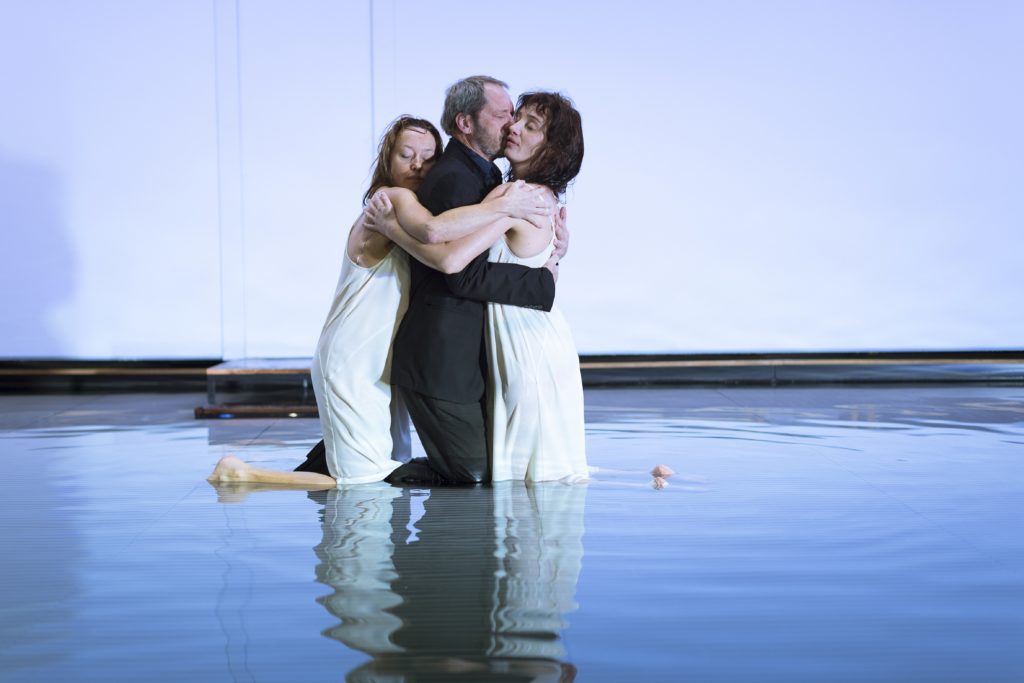Ivo van Hove Stages 2 Bergman Works
By • April 19, 2018 0 951

Back in the day — the 1950s and ’60s — many young Americans with a creative bent discovered the mysterious joys, puzzlements and challenges of foreign films and their directors.
We went to smallish theaters showing the mostly black-and-white artistic endeavors of startlingly different directors: the kinetic, epic eroticism of Fellini, the stern stillness of Antonioni, the energetic, cinematically deft Truffaut, the anarchistic Godard and the sometimes impenetrable Resnais.
But no director, it seemed to many of us, was as challenging, emotionally charged (even if the emotions were often chilling and despairing) and thought-provoking as the Swedish director Ingmar Bergman (“not to be confused with Ingrid Bergman,” suggests a Wikipedia entry). He cast a huge shadow with his films. Bergman was not only prolific but critically acclaimed and admired, which was also true of his work in the theater.
His most famous films are oddly diverse: the medieval masterworks “The Virgin Spring” and “The Seventh Seal,” the powerfully intimate “Persona,” “Cries and Whispers” and “Scenes from a Marriage” and, late in his career, the remarkably Dickensian “Fannie and Alexander.”
Bergman, who died in 1970 at the age of 89, also had a profound effect on and inspired the acclaimed Belgian director Ivo van Hove, best known for his work in the arena of classic and contemporary theater. His churning, Tony Award-winning version of Arthur Miller’s “A View from the Bridge” was seen at the Kennedy Center in 2016.
“There is no question in my mind,” said van Hove in a phone interview. “I consider Bergman an artistic giant of the 20th century. His body of work in film and theater explored what it was like being human.
“He showed us the complexities, and the fears of the human state. He was surgical in his work. He showed us, strip by strip, human beings.”
That, surely, is also a part of the production of two Bergman works, “After the Rehearsal” and “Persona,” which van Hove, with his Toneelgroep Amsterdam company, brings to the Kennedy Center Eisenhower Theater April 19 to 22.
In many ways, the two plays reflect both men’s concerns, their interests in creativity and art and their importance to human beings — Bergman’s more in film, van Hove’s in theater.
“‘After the Rehearsal’ is about a director who is most alive, most comfortable on the stage, in the theater,” van Hove said. “It’s almost his whole life, a life in the world of illusions, like ‘Macbeth.’ It gives meaning to his life. He has difficulty dealing with other people apart from that, living in real life. ‘Persona,’ on the other hand, focuses on the life of an actress, who suddenly stops talking.
“In these times, when, among other things, we are continually debating the importance of art in society, we find ourselves having to defend this importance more and more often. I find that highly interesting both personally and as a theater maker,” he said.
Asked about the amount of time he spent on the staging, he said, “a lot, a lot of time.”
Both plays, incidentally, are visually informed (as are most of the plays he takes on) by sets by designer Jan Versweyveld, who is also van Hove’s partner.
Judging from his voluminous track record, van Hove is deeply engaged with the idea of classic theater, and not just in its traditional forms of Greek tragedy or the works of Shakespeare. On a trip to Greece, he visited the Acropolis. “I was overwhelmed. To be here, when culture and art combined with society,” he said.
He admires what he considers the American masters of tragedy. “You have O’Neill, of course, and Milller.” He’s done “The Crucible” (Olney Theatre Center’s production runs through May 20), commenting: “That play, as do many others, change over time. It’s not merely about politics and McCarthy.” Van Hove also predates the current popularity of reviving “Angels in America,” which he called “an epic tragedy, or perhaps an epic tragicomedy.”
“A View from the Bridge” is a play about immigrants, and it echoes today. But it is also a classic tragedy about families, in which an Italian American longshoreman develops inappropriate feelings toward his young niece who lives with him, with devastating, tragic results.
The production here, the staging and the acting played like a chamber music work performed by a symphony orchestra. It was both very modern in some of its ideas and looks and lean, stripped to tragic levels physically.
It was, in the end, a tragedy about what it means to be human.

